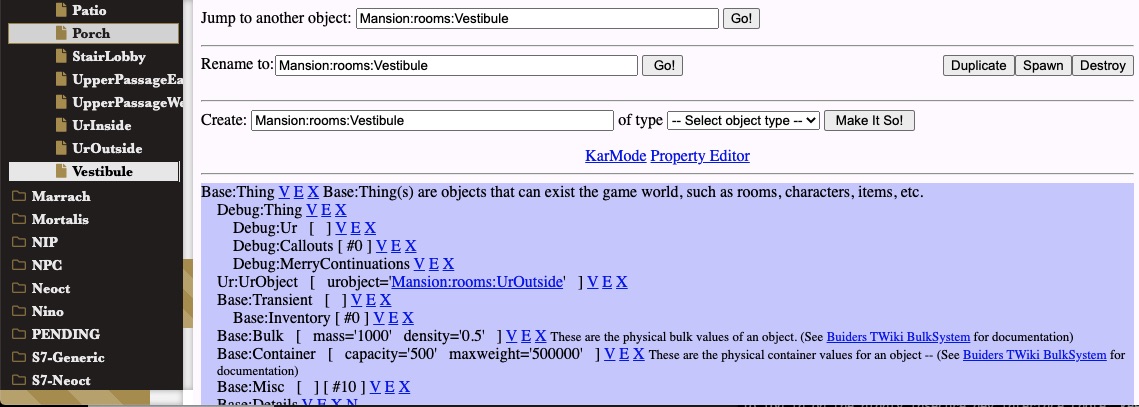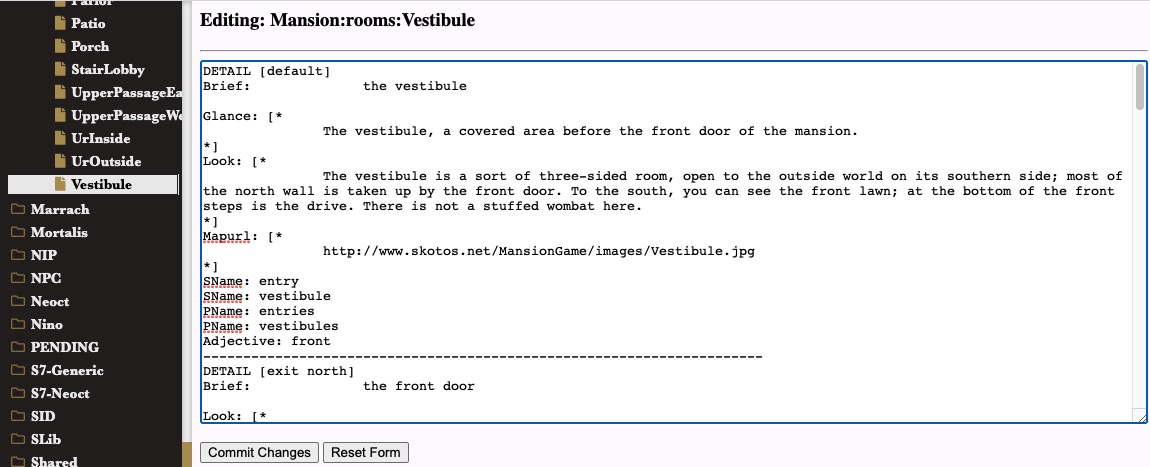Your First Week: Changing Locations
The Tree of WOE is your basic editor of in-game objects. If you want to create new locations or new props, that should be your first stop.
So let's get started.
(Before you do this, make sure you have The Gables running locally or on a VPS and that you can connect to the Tree of WOE from your auth server's web pages.)
Changing a Room
Let's find our start room, the one you're probably standing in.
The list on the left is a set of nested categories. We'll be looking for Mansion:rooms:Vestibule. So start by looking for "Mansion", and inside that you should find "rooms" and then "Vestibule". And that's the starting room for new characters in The Gables, such as (presumably) yourself.

The default editing interface is opaque and a bit clunky. If you want you can [V]iew, [E]dit, Edit as [X]ML or [D]elete most things. But there's a different choice to edit the item as a whole that I like better.
Let's go to KarMode, which is easier for just changing the text of the room. It renders the room's properties as a sort of MarkDown-like format that represents it. You change the markdown and then that changes the object.
Hit "KarMode" in WOE and you should see something like this:

You'll notice that the text on yours does not include the phrase "there is not a stuffed wombat here." I think that's an unfortunate omission. Go ahead and add it. Or anything else you feel like — it's your game, after all.
After you've added what you want to, hit the "Commit Changes" button at the bottom, which should bring you back to the WOE interface.
Now open a new Chrome window to localhost:2072 or your gables-login URL, log in and hit "Play". If you've moved away from the Vestibule, head back to it now.
You may need to type "look" to see your changes to the room description. But once you've changed them in the Tree of WOE, you don't need to do anything beyond hitting "Commit". Look again and the changes should be there. That's a lot more satisfying than messing with XML files and rebooting.

Looking Around the Room
That complicated Tree of WOE screen has a lot of interesting information on it about the Vestibule. The top blue line (Base:Thing) has V, E and X letters after it. Hit [X] to see the whole object rendered as XML. You can also do the same with just small pieces of the object, which is neat.
Not every property makes sense for every object. For instance, that Base:Bulk entry? That's how bulky you would find the room to be if you picked it up and carried it around with you. That's not actually a sensible thing — the game won't let you pick up the room, so the Bulk turns out not to matter for this specific object. So: don't be shocked if some parts of the object don't make sense for some objects. There could be a bulk, but it's ignored. Or a "fatigue" rating for a simple object. Or a Base:Crafting entry for something that can't be crafted or used to craft anything. Don't sweat it.
Persistent? Only Sort Of
Of course, if you delete skotos.database and do a full cold boot you'll lose those changes. We'll talk about how to fix that later. For right now, just know: there's an extra step if you want to export your changes to XML and share them with other people, or persist them through a reboot with no statedump.
But if you make sure to use statedump files, you'll keep this kind of changes, and all your other changes. Only some changes are designed to be sync'd, exchanged and copied around. But the statedump keeps all changes at every level, from Merry and WOE to the lowest-level DGD-language changes to data structures and memory.